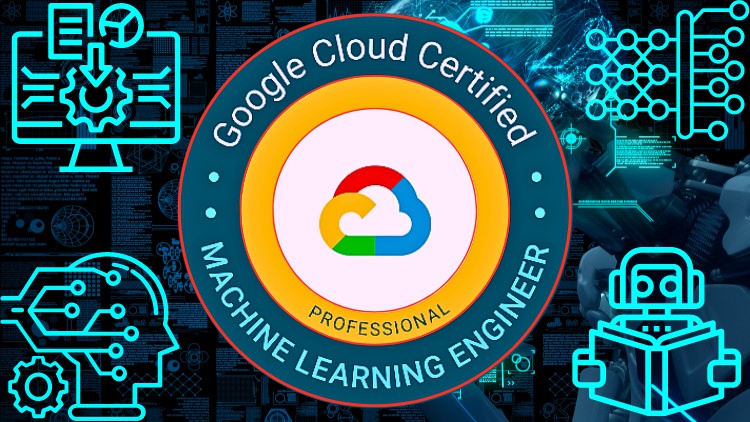
Master ML Algorithms, Data Modeling, TensorFlow & Google Cloud AI/ML Services. 137 Questions, Answers with Explanations
What you will learn
Framing ML problems
Architecting ML solutions
Designing data preparation and processing systems
Developing ML models
Automating and orchestrating ML pipelines
Monitoring, optimizing, and maintaining ML solutions
Description
Note➛ Make sure your 𝐔𝐝𝐞𝐦𝐲 cart has only this course you're going to enroll it now, Remove all other courses from the 𝐔𝐝𝐞𝐦𝐲 cart before Enrolling!
- Translate business challenges into ML use cases
- Choose the optimal solution (ML vs non-ML, custom vs pre-packaged)
- Define how the model output should solve the business problem
- Identify data sources (available vs ideal)
- Define ML problems (problem type, outcome of predictions, input and output formats)
- Define business success criteria (alignment of ML metrics, key results)
- Identify risks to ML solutions (assess business impact, ML solution readiness, data readiness)
- Design reliable, scalable, and available ML solutions
- Choose appropriate ML services and components
- Design data exploration/analysis, feature engineering, logging/management, automation, orchestration, monitoring, and serving strategies
- Evaluate Google Cloud hardware options (CPU, GPU, TPU, edge devices)
- Design architectures that comply with security concerns across sectors
- Explore data (visualization, statistical fundamentals, data quality, data constraints)
- Build data pipelines (organize and optimize datasets, handle missing data and outliers, prevent data leakage)
- Create input features (ensure data pre-processing consistency, encode structured data, manage feature selection, handle class imbalance, use transformations)
- Build models (choose framework, interpretability, transfer learning, data augmentation, semi-supervised learning, manage overfitting/underfitting)
- Train models (ingest various file types, manage training environments, tune hyperparameters, track training metrics)
- Test models (conduct unit tests, compare model performance, leverage Vertex AI for model explainability)
- Scale model training and serving (distribute training, scale prediction service)
- Design and implement training pipelines (identify components, manage orchestration framework, devise hybrid or multicloud strategies, use TFX components)
- Implement serving pipelines (manage serving options, test for target performance, configure schedules)
- Track and audit metadata (organize and track experiments, manage model/dataset versioning, understand model/dataset lineage)
- Monitor and troubleshoot ML solutions (measure performance, log strategies, establish continuous evaluation metrics)
- Tune performance for training and serving in production (optimize input pipeline, employ simplification techniques)
English
language
Content
Introduction
Introduction
How to Improve Data Quality
Exploratory Data Analysis (EDA)
How EDA is Used in Machine Learning
Data analysis and visualization
Supervised Learning
Linear Regression
Logistic Regression
Machine Learning Vs. Deep Learning
Automated Machine Learning
Evaluating AutoML Models
ML Model Using BigQuery ML
BigQuery ML Model Types
Introduction to Neural Networks and Deep Learning
Gradient Descent
Loss Functions
Activation Functions
Ensemble Methods
Tensorflow, Tensorflow on Google Cloud
Introduction to Tensorflow
Tensorflow – Scalar, Vector, Matrix, 4D Tensors
Tensorflow APIs
Tensorflow’s tf.data.Dataset APIs
TensorFlow Data Handling
Embeddings
TensorFlow 2 and the Keras Functional API
TensorFlow Extended (TFX) Overview
Architecture for MLOps using TensorFlow Extended, Vertex AI Pipelines, and Cloud
Vertex AI
Create Custom Training Jobs
Export model artifacts for prediction
Vertex AI Feature Store
Vertex AI Model Monitoring
Vertex Explainable AI
Vertes AI Vizier
BigQuery ML
Feature Engineering in BigQuery
Practice Questions & Answers
Part 1 – 10 Questions
Part 2 – 10 Questions
Part 3 – 10 Questions
Part 4 – 10 Questions
Part 5 – 10 Questions
Part 6 – 10 Questions
Part 7 – 10 Questions
Part 8 – 10 Questions
Part 9 – 10 Questions
Part 10 – 10 Questions
Part 11 – 10 Questions
Part 12 – 10 Questions
Part 13 – 10 Questions
Part 14 – 7 Questions